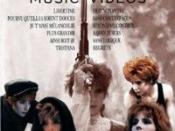Introduction
Music videos are a phenomenon in visual and music culture that have become somewhat forgotten. Since the 1990s, MTV has moved away from their primary use of music video delivery, in favor of a more generalized youth programming. They have grown to favor reality television programming in the scheme of the Real World, Road Rules and network television shows like Survivor. However, unable to abandon music videos completely, MTV was forced to create a new channel on the dial, now currently available on a widespread basis to digital cable and satellite subscribers. MTV2 is the channel which reinstated what the original function of MTV was when it was started in 1980, which is to continuously deliver music videos as an evolved presentation of popular music, 24 hours a day.
Clearly with the incarnation of MTV2 in the 1990s, we can see that the demand for music videos, while not necessarily on the primary agendas of MTV executives these days, could not be denied.
VH1 has likewise released their recent channel, VH1 Classic, which is a throwback to their original purpose of continually showing the music videos of a more mature audience. VH1 Cassic pulls and airs all the videos from the archives of the 80s and 90s, as well as anything from even further back that they may have. Their primary station however, has become a myriad of top 10 countdown lists in a Nick Hornby, High Fidelity bad acid trip, deplete of music videos almost altogether until late night airing hours. VH1 Classic could be considered VH2 in this scheme of things.
These programming statistics are however less interesting than the videos themselves, which as mentioned, have clearly proven that their appeal has transcended corporate program scheduling of music video alternative shows. In fact, this entire discussion should...


